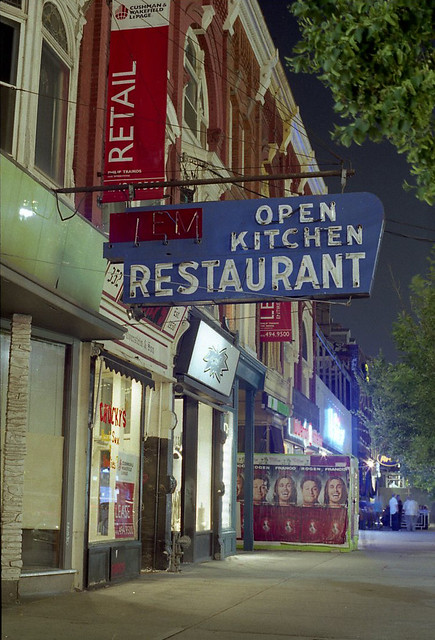The Single Digit Olympus OM Camera Experience
Originally published on the Film Shooters Collective May 19, 2016
Within the Film Shooters Collective I know there are few photographers that have at least one Olympus OM body within their kit. I'm not only a film shooter but also a camera collector with an extensive collection including Nikon, Pentax Screwmounts, a pair of Leica M rangefinders, a Minolta SRT 102, Canon FD gear and a whole bunch of Olympus. I currently own three OM-1s, an MD and an N model, a pair of OM-2n’s that work like a dream, another one that's a paperweight and one pristine OM-4. Over the years my OM bodies have travelled extensively. They've been skiing with me in the winter, hiking other times of the year, spent much time in my briefcase on my many trips into Toronto (so I can do some shooting before or after business meetings or night class) and on a week long trip to New York City back in 2012.

Within the Film Shooters Collective I know there are few photographers that have at least one Olympus OM body within their kit. I'm not only a film shooter but also a camera collector with an extensive collection including Nikon, Pentax Screwmounts, a pair of Leica M rangefinders, a Minolta SRT 102, Canon FD gear and a whole bunch of Olympus. I currently own three OM-1s, an MD and an N model, a pair of OM-2n’s that work like a dream, another one that's a paperweight and one pristine OM-4. Over the years my OM bodies have travelled extensively. They've been skiing with me in the winter, hiking other times of the year, spent much time in my briefcase on my many trips into Toronto (so I can do some shooting before or after business meetings or night class) and on a week long trip to New York City back in 2012.

Olympus has always made interesting gear, including a TLR (if you can find one), the 35mm Pen F half frame camera system and, for one year, a Pentax Screwmount SLR called the FTL and, from what I read the lenses were really good. Yoshihisa Maitani, chief camera designer at Olympus, gave the world the M-1 at Photokina in 1972. It didn’t stay as an M-1 for long because the legal department at Leitz wasn't too happy with the model designation and threatened legal action, so the OM-1 was born. In the used market M-1s command a premium due to this historical footnote, although, cosmetically and mechanically they were the same as the OM-1.
Up until then 35mm SLRs were tanks with perhaps the most compact SLR being the Pentax Spotmatic series. The OM-1 was the one full frame SLR you could hold comfortably in one hand and it influenced camera design for the rest of the 1970s and onward, with Nikon replacing the Nikkormat series with the FM/FE and Pentax replacing the higher end K series with the MX and ME.
The OM-1 was joined a few short years later with the auto exposure OM-2 which perhaps was even more of an engineering jewel with the electronics put into the same OM-1 body. By 1978 both bodies were mechanically improved and became the OM-1n and OM-2n respectively. If you’re looking to collect and invest these are the ones to look for, I’ll tell you why later.
Technology never sleeps and, in 1984, Olympus introduced the mechanical shutter OM-3 and auto exposure OM-4 (both cameras had spot metering as the great leap forward). Shortly afterwards the OM-2 Spot Program (OM-2S in the USA) came along. All three cameras had spot metering and were marketed for advanced photographers. Now, the one big Achilles heel for the OM-2S, OM-3 and OM-4 was the battery drain, even when turned off. My solution, take the batteries out if you are not planning to use the camera for an extended period.
As a side note, the OM-3 in its day was a sales failure. The OM-1n, the other mechanical shutter camera in the Olympus line up, was still available and cheaper to buy, essentially cannibalizing the OM-3's market until both were discontinued in 1986. These days OM-3s command a premium in the camera collector's market compared to the OM-4.
In 1987, Olympus rectified the battery drain by improving the electronics, creating the OM-4Ti (the OM-4T in the US market) and introducing the OM-3Ti in 1994. Both cameras came with TTL flash automation and had titanium top and bottom covers. The OM-3Ti didn't sell well compared to the OM-4Ti resulting in insane prices over $1000 US per body on Ebay. OM-4T(i)’s in comparison are more reasonable in around the $400 US mark on average. Both cameras were discontinued in 2003 when Olympus made the big leap into the digital market with the 4/3 system.
The single digit OM series were the Saab 900 of 35mm SLRs with their different ergonomics compared to Nikon, Canon, Pentax and other SLR manufacturers. The bodies were well engineered and, while the majority of photojournalists shied away from the OM-system, the scientific community and adventurer/explorer/wildlife photographer market loved them. If weight was a factor for you the OM system won hands down when compared to a Nikon F2A or Canon F-1N with lenses. The really big draw with Olympus was their Zuiko optics, just as it is today with their mirrorless digital bodies.
I know that look, you think this seems like a cool system to invest in. So far, I have given you a really topline overview on the history of the system. If you’re toying with the idea of getting a body or two and some glass, I'm going to recommend the OM-1md or OM-1n and the OM-2n. The Olympus OM-4 is a neat camera but it’s a battery pig and I wouldn't recommend it as your one and only OM body. The OM-1n, though a mechanical camera, still needs a 625 (1.35v) mercury cell battery which has been banned for years. There are work arounds, either with the Wein Cell or a MR-9 CHRIS adapter. The OM-2n has no battery problems because it takes a pair of 1.5 silver oxide batteries.
Another issue you have to watch for, with any single digit OM body, is overlapping frames. This is caused by the film advance clutch mechanism, which over time starts to slip. You won’t know it has until the film has been processed. This can be cured with an overhaul. I'm fortunate to have a camera tech within driving distance who can work on the OM-1 (n) and to some extent OM-2n. For anything more complex, in North America I recommend Zuiko.com. The turn around time is about four months but your camera will come back working better than ever.
So, lenses. If you’re on a budget I recommend the Zuiko 50 f1.8 lens. It is a sharp piece of glass. Among Olympus fans there is a debate on which is the best version during this lens’ long production run. I swear by my MC (multi-coated) though others love the “Made in Japan” series. Chrome nose lenses are early production and, to my understanding, single coated. If you’re after a vintage look, these are the ones you want.
Now, If you have more money the 50 f1.4 MC lens is the go to 50mm lens, but you’ll be paying a premium to get a slightly faster lens and multi coating. In wide-angle lenses, I recommend the 28 f3.5. They are cheap, sharp as a tack and have remained with the same optical formula through its production run. In medium telephotos, save your money and get the 100 f2.8, it’s compact and perfect for portraits and landscape work. If you’re looking for something longer, the 200 f4 is a great telephoto lens.
One caveat with Zuiko lenses is that, outside standard focal lengths and speeds ( 28 f2.8, 50 f1.4, 100 f2.8), they can get crazy expensive. For example, the 40 f2 Pancake lens usually goes for about $600 USD, it’s compact to the point you can put your OM-1 or 2n in a trench coat pocket, but the lens performance is nothing to write home about compared to the 50 f1.8 or f1.4. Another example is the 24 f2 Zuiko lens that goes for an average $500 on Ebay. It depends how much of a budget you have and what you are shooting in terms of subject matter.
One of the coolest things with the OM-2n and later bodies is that you have off the film plane metering for your T-32 flash, which makes for more accurate exposures. If you only have the OM-1 that is pre-n series, go for a Vivitar 283 “Sledgehammer” and you’re set in terms of on camera flash.
The Olympus OM-1n and OM-2n are my recommended bodies. They are younger than other cameras and won’t cost a huge amount of money to repair if needed. If you already have them and want to go a little more feature heavy, the OM-4 is a great piece of engineering (If you remember to remove the batteries after you use it!). Alternately, if you have more money in the acquisition budget, get the OM-4ti which is the last single digit OM body.
OM bodies, as mentioned earlier, are a little more exotic and not as many repair techs are comfortable fixing the electronic shutter and spot meter models (OM-2/3/4). One of my OM-2n’s had a jumpy meter and my local repair tech didn't want to repair it due to a lack of parts availability, so I had to send it down to Zuiko.com for service. That said, these are super reliable cameras with amazing lenses. They are worth the investment as tools for making mind-blowing photographs.
If you want to go deeper into Olympus OM gear I recommend the following sites:
Photography in Malaysia
http://www.mir.com.my/rb/photography/hardwares/classics/olympusom1n2/index.htm
http://www.mir.com.my/rb/photography/hardwares/classics/olympusom1n2/index.htm







Comments